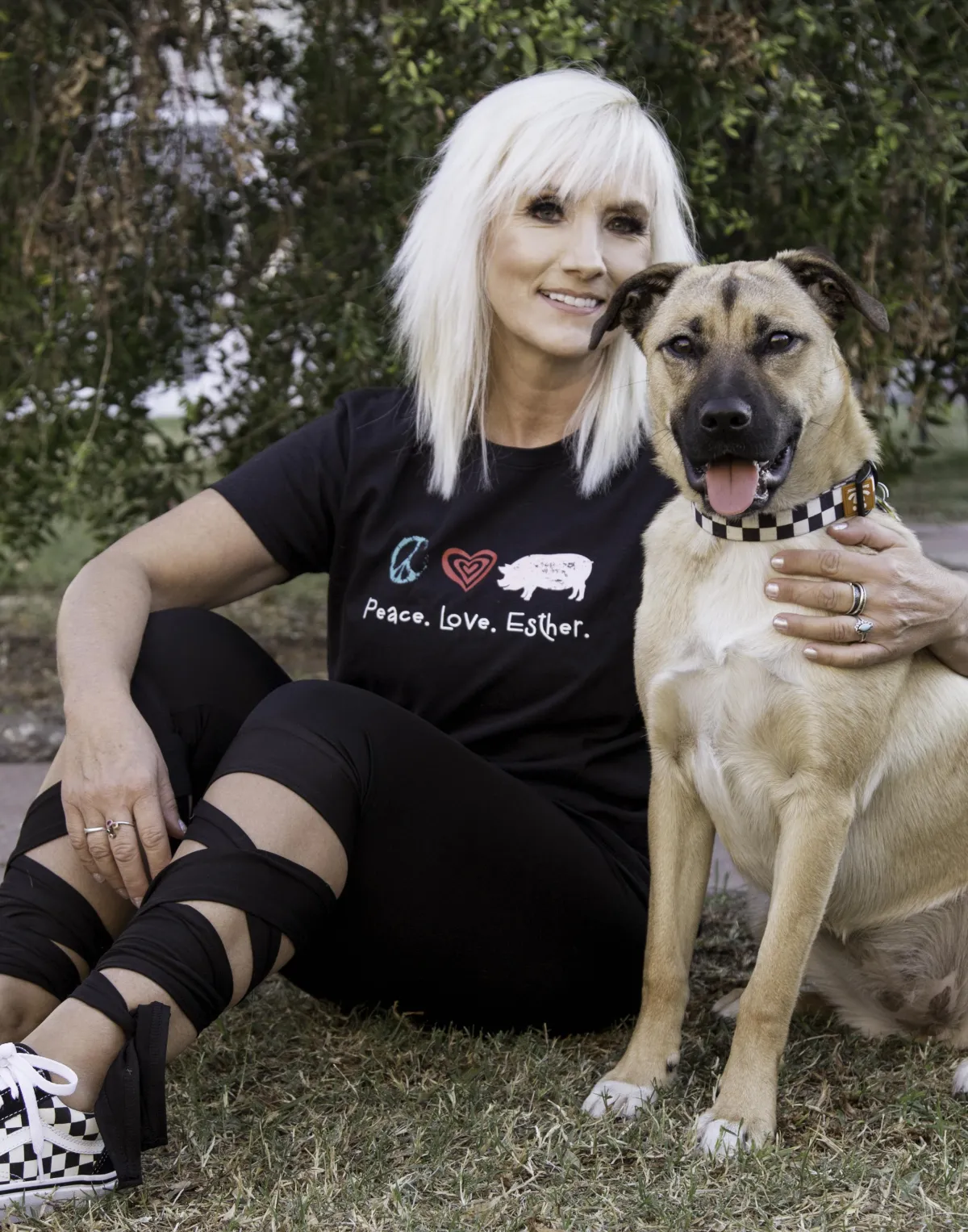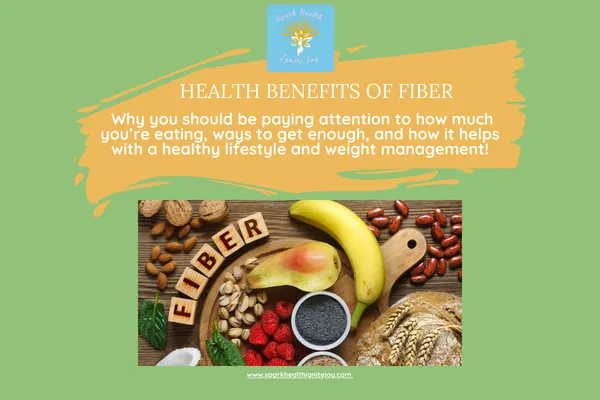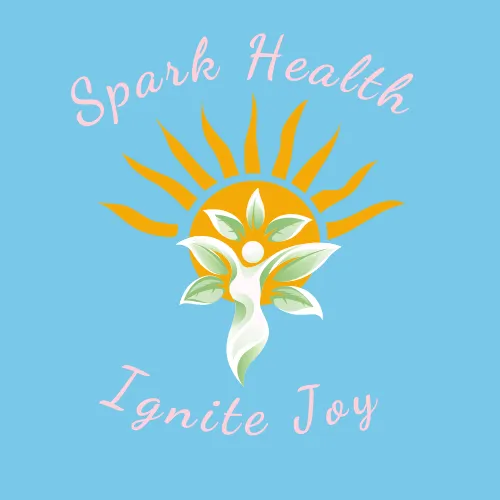Welcome to my Blog!

About the Blogger
Hi, I'm Wendy!
I'm an EXPERT in fun, joy and living life with a "you gotta put in the hard work for what you want (but still have fun doing it!) and the rewards are SO worth it" mantra for success and getting the most out of life!
I'm a CERTIFIED EXPERT in fitness, nutrition, weight loss and coaching from a habits-based, whole foods plant-based perspective that is all about GOOD HEALTH for life.
My passion is helping people truly find and live their optimal lives through making the connections between optimal health and a joyful, fulfilled life.
Through online courses and meal plan coaching, I teach strategies for good habits, good health, making things easier for yourself, and being good to yourself and others.

The Health Benefits of Fiber
What do you think of when you hear the word “fiber” and that you should have it in your diet? Do you just shrug and think “whatever, it’ll just take care of itself”. You’ve likely heard from somewhere or other that you need to have fiber in your diet for optimal health. But what exactly IS fiber? Where does it come from? What are the real benefits of it, how much of it do you really need, where do you get fiber from in the foods you eat, and how can you incorporate fiber into your daily diet so you make sure you’re getting adequate amounts?????
So…..
WHAT IS FIBER AND WHERE DOES IT COME FROM?
Fiber is sometimes called “roughage”. When I hear that term, I think of the hay that I used to feed my horse hahaha. But it applies to us humans too, just not with hay. At its essence, dietary fiber is basically the parts of carbohydrates - in the form of plant foods like fruits, vegetables, grains and legumes - that your body doesn’t digest or absorb. While humans are able to easily break down and digest the starches in carbohydrates they eat, the rest of the plant fiber passes through undigested. This is because our bodies don’t produce the enzymes needed to break them down. This is by design though. It isn’t that something is wrong with our bodies that we can’t. We actually NEED this undigested fiber to keep our bodies healthy. A small amount of this undigested fiber does undergo some fermentation in the large intestine as it passes through and this provides our bodies with a small amount of energy for normal gut bacterial growth - the “healthy bacteria” we need for optimal gut health.
There is also a kind of fiber that is sometimes added to food products that is called “functional fiber”, but we will focus on getting fiber from natural food products as it is very easy to get enough when eating a healthy, whole foods diet.
What do you think of when you hear the word “fiber” and that you should have it in your diet? Do you just shrug and think “whatever, it’ll just take care of itself”. You’ve likely heard from somewhere or other that you need to have fiber in your diet for optimal health. But what exactly IS fiber? Where does it come from? What are the real benefits of it, how much of it do you really need, where do you get fiber from in the foods you eat, and how can you incorporate fiber into your daily diet so you make sure you’re getting adequate amounts?????
So…..
WHAT IS FIBER AND WHERE DOES IT COME FROM?
Fiber is sometimes called “roughage”. When I hear that term, I think of the hay that I used to feed my horse hahaha. But it applies to us humans too, just not with hay. At its essence, dietary fiber is basically the parts of carbohydrates - in the form of plant foods like fruits, vegetables, grains and legumes - that your body doesn’t digest or absorb. While humans are able to easily break down and digest the starches in carbohydrates they eat, the rest of the plant fiber passes through undigested. This is because our bodies don’t produce the enzymes needed to break them down. This is by design though. It isn’t that something is wrong with our bodies that we can’t. We actually NEED this undigested fiber to keep our bodies healthy. A small amount of this undigested fiber does undergo some fermentation in the large intestine as it passes through and this provides our bodies with a small amount of energy for normal gut bacterial growth - the “healthy bacteria” we need for optimal gut health.
There is also a kind of fiber that is sometimes added to food products that is called “functional fiber”, but we will focus on getting fiber from natural food products as it is very easy to get enough when eating a healthy, whole foods diet.
- Aids in achieving healthy weight. High-fiber foods tend to be more filling than low-fiber foods, so you're likely to eat less and stay satisfied longer. And high-fiber foods tend to take longer to eat and to be less "energy dense," which means they have fewer calories for the same volume of food. As well as helping with digestion and preventing constipation, fiber adds bulk/roughage to your diet, a strong factor in both losing weight and maintaining a healthy weight. Adding bulk/roughage helps you feel full sooner. Since fiber stays in the stomach longer than other foods, that feeling of fullness will stay with you much longer, helping you to eat less. High-fiber foods such as fruits and vegetables tend to be low in calories, so by adding fiber to your diet, it’s easier to cut calories.
There are other ways that a high fiber intake can aid weight loss:
By regulating your blood sugar levels, it can help maintain your body’s fat-burning capacity and avoid insulin spikes that leave you feeling drained and craving unhealthy foods.
Eating plenty of fiber can move fat through your digestive system at a faster rate so that less of it can be absorbed.
When you fill up on high-fiber foods such as fruit, you’ll also have more energy for exercising.
- Helps you live longer. Studies suggest that increasing your dietary fiber intake — especially cereal fiber — is associated with a reduced risk of dying from cardiovascular disease and all cancers.
- Digestive health. Dietary fiber normalizes bowel movements by bulking up feces and making them easier to pass. This can help relieve and prevent both constipation and diarrhea. Eating plenty of fiber can also reduce your risk for diverticulitis (inflammation of the intestine), hemorrhoids, gallstones, kidney stones, and provide some relief for irritable bowel syndrome. Some studies have also indicated that a high-fiber diet may help to lower gastric acid and reduce your risk for gastroesophageal reflux disorder (GERD) and ulcers.
- Diabetes. A diet high in fiber—particularly insoluble fiber from cereals—can lower your risk for type 2 diabetes. If you already have diabetes, eating soluble fiber can slow the absorption of sugar and improve your blood sugar levels.
- Cancer. There is some research that suggests eating a high-fiber diet can help prevent colorectal cancer, although the evidence is not yet conclusive. Diets rich in high-fiber foods are also linked to a lower risk for other common digestive system cancers, including stomach, mouth, and pharynx.
- Skin health. When yeast and fungus are excreted through the skin, they can trigger outbreaks or acne. Eating fiber, especially psyllium husk (a type of plant seed), can flush toxins out of your body, improving the health and appearance of your skin.
- Heart health. Fiber, particularly soluble fiber, is an important element of any heart-healthy diet. Eating a diet high in fiber can improve cholesterol levels by lowering LDL (bad) cholesterol. A high fiber intake can also reduce your risk for metabolic syndrome, a group of risk factors linked to coronary heart disease, diabetes, and stroke. Fiber can also help to lower blood pressure, reduce inflammation, improve levels of HDL (good) cholesterol, and shed excess weight around the abdomen.
HOW MUCH FIBER DO WE NEED?
Many people do not eat adequate amounts of fiber daily. However, it is easy to meet daily fiber requirements for optimal health by eating a healthy diet that includes portions of fruits, vegetables, whole grains and legumes daily.
For most adults, daily fiber amounts should be approximately 25-35 grams per day but more is okay too! Research suggests that many adults are only getting about half that amount in their daily diets. That is not okay for achieving long-term health benefits. With the health benefits AND benefits for helping with weight loss and maintaining a healthy weight - because most high fiber foods are also low in calories so you can eat a larger portion and feel full longer - there is every reason to try to hit your fiber goals each day.
While it may seem hard at first to get the recommended amount of fiber in your diet, once you start eating healthy, whole foods including whole grains, legumes, fruits and vegetables, you’ll very easily meet your goals.
WAYS TO GET MORE FIBER INTO YOUR DIET
The good news is that it is actually really easy to meet your daily fiber goals with attention to what kinds of foods you are eating. Refined and processed foods are low fiber foods. Don’t fill your plate with these foods. You get the most bang for your fiber buck from eating whole, unprocessed, healthy foods. It’s not hard to meet your fiber goals with “real” food!
Start your day with fiber: Look for whole grain cereals to boost your fiber intake at breakfast. Oatmeal or oat bran is an awesome way to start your day with good fiber and no extra sugars. But simply switching your breakfast cereal from Corn Flakes to Bran Flakes can add an extra 6 grams of fiber to your diet; switching to All-Bran or Fiber-One will boost it even more. If those cereals aren’t to your liking, try adding a few tablespoons of unprocessed wheat bran to your favorite cereal. Always check the labels and choose natural, whole grain cereals with a minimum of 5 grams of fiber per serving. NOTE! Don’t be fooled by cereal packages that claim to be high fiber but ALSO are high sugar. Choose instead a cereal with the label showing whole grains as their main ingredient and sugar products NOT in the first 4 or 5 ingredients.
Replace white rice, bread, and pasta with brown rice and whole grain products: Experiment with wild rice, barley, whole-wheat pasta, and bulgur. These alternatives are higher in fiber than their more mainstream counterparts—and you may find you love their tastes. Choose whole grain bread for toast and sandwiches.
Add fiber to your baking: When baking at home, substitute whole-grain flour for half or all of the white flour, since whole-grain flour is heavier than white flour. In yeast breads, use a bit more yeast or let the dough rise longer. Try adding crushed bran cereal or unprocessed wheat bran to muffins, cakes, and cookies. Or add psyllium husk to gluten-free baked goods, such as breads, pizza dough, and pasta.
Add flaxseed. Flaxseeds are small brown seeds that are high in fiber and omega-3 fatty acids, which can lower your total blood cholesterol. Important note: Always grind the seeds in a coffee grinder or food processor because unground flaxseeds just pass right through you. You can add them to yogurt, applesauce, or breakfast cereals. Chia seeds are also great to add and you don’t have to grind them.
Fiber from fruit and vegetables are an easy way to get lots of fiber and you should include these foods in each meal and snack. Here are some easy ways to do that:
Add fruit to your breakfast: Berries are high in fiber, so try adding fresh blueberries, raspberries, strawberries, or blackberries to your morning cereal or yogurt.
Keep fruit and vegetables with you: Wash and cut fruit and veggies and put them in your refrigerator for quick and healthy snacks. Choose recipes that feature these high-fiber ingredients, like veggie stir-fries or fruit salad.
Replace dessert with fruit: Eat a piece of fruit, such as a banana, apple, or pear, at the end of a meal instead of dessert.
Eat whole fruits instead of drinking fruit juice: You’ll get way more fiber and consume fewer calories. An 8oz. glass of orange juice, for example, contains almost no fiber and about 110 calories, while one medium fresh orange contains about 3g of fiber and only 60 calories. Fruit juices, without the fiber of whole fruit, also add too much sugar to your diet and less nutrients compared to eating the whole fruit. Better to add the whole fruit to a smoothie and get all the benefits of the fruit - vitamins, minerals, and fiber.
Don’t peel your fruit: Peeling can reduce the amount of fiber in fruits and vegetables, so eat the peel of fruits such as apples and pears.
Incorporate veggies into your cooking: Add pre-cut fresh or frozen vegetables to soups and sauces. For example, mix chopped frozen broccoli into prepared spaghetti sauce or toss fresh baby carrots into stews.
Bulk up soups and salads: Liven up a dull salad by adding nuts, seeds, kidney beans, peas, or black beans. Artichokes are also very high in fiber and can be added to salads or eaten as a snack. Beans, peas, lentils, and rice make tasty high-fiber additions to soups and stews.
Add legumes: Add kidney beans, peas, or lentils to soups or black beans to a green salad.
Make your snacks fiber-full: Fresh and dried fruit, raw vegetables, and rice cakes are all good ways to add fiber at snack time. A handful of nuts can also make a healthy, high-fiber snack.
When eating out: It can be hard to find fiber-full foods when eating out particularly at fast food places. Some ways you can make better choices are choosing a whole wheat bun/bread with your burger or sandwich, choosing a veggie burger over a meat burger, choosing foods with beans, adding nuts or seeds to a salad, choosing a baked potato over fries or potato chips, and adding a salad or fruit.
NOTE:
If you have had a lack of high fiber foods in your diet, for some people it can work best to start by gradually adding fiber to your diet so your body adjusts. For some people, suddenly adding a large amount of fiber to your diet can sometimes cause side effects such as abdominal cramps, intestinal gas, bloating, or diarrhea. These are temporary effects and should go away once your digestive system becomes used to the increase. Many people experience none of these temporary effects and just start feeling a lot better when they increase their fiber intake.
It is also important to increase your water intake as you increase fiber. Fiber absorbs water so the more fiber you add to your diet, the more fluids you should drink to keep your body utilizing the fiber in a healthy way.
EXAMPLES OF FOODS AND FIBER CONTENT:
See how easy it is to reach your daily recommended fiber intake? Here’s some typical foods and the amounts of fiber they contain, to show you.
Good Sources of Fiber
Food Serving size and Fiber grams
Cereals
Fiber One 1/2 cup, 14 grams
All-Bran 1/2 cup, 10 grams
Bran Flakes 1 cup, 7 grams
Shredded Wheat 1 cup, 6 grams
Oatmeal (cooked) 1 cup, 4 grams
Vegetables
Spinach (cooked) 1 cup, 4 grams
Broccoli 1/2 cup, 3 grams
Broccoli 1/2 cup, 3 grams
Carrots 1 medium, 2 grams
Brussels sprouts 1/2 cup, 2 grams
Green beans 1/2 cup, 2 grams
Baked goods
Whole-wheat bread 1 slice, 3 grams
Bran muffin 1, 2 grams
Rye bread 1 slice, 2 grams
Rice cakes 2, 1 gram
Legumes (cooked)
Lentils 1/2 cup, 8 grams
Kidney beans 1/2 cup, 6 grams
Lima beans 1/2 cup, 6 grams
Baked beans (canned)** 1/2 cup, 5 grams
Green peas 1/2 cup, 4 grams
Grains (cooked)
Barley 1 cup, 9 grams
Wheat bran, dry 1/4 cup, 6 grams
Spaghetti, whole wheat 1 cup, 4 grams
Brown rice 1 cup, 4 grams
Bulger 1/2 cup, 4 grams
Fruit
Pear (with skin) 1 medium, 6 grams
Apple (with skin) 1 medium, 4 grams
Strawberries (fresh) 1 cup, 4 grams
Banana 1 medium, 3 grams
Orange 1 medium, 3 grams
Dried fruit (note: these have much more sugar than fresh fruit so eat in limited quantities)
Prunes 6, 2 grams
Apricots 5 halves, 2 grams
Raisins 1/4 cup, 2 grams
Dates 3, 2 grams
Plums 3, 2 grams
Nuts and seeds
Peanuts, dry roasted* 1/4 cup, 3 grams
Walnuts 1/4 cup, 2 grams
Popcorn* 1 cup, 1 gram
Peanuts* 10, 1 gram
Filberts, raw 10, 1 gram
* Choose no-salt or low-salt version of these foods,
Choose low-sugar version of these foods
Source: Healthguide.org
NOTE: Yes, there are fiber supplement products on the market - powders, gummies, pills - but these should only be used rarely as you really can get the fiber you need from real foods. The advantages of supplementing with these products can be if you are traveling, for example, or for some reason in a temporary situation where you can’t eat the foods you know provide healthy fiber. But the disadvantages are that these products make you miss out on the vitamins, minerals and other nutrients you get when eating real, whole foods (and these are so important!), the supplements don’t help with weight loss or maintenance as they don’t help you to feel full, supplements can interact with some other medications you may be taking so always check with your doctor first, and also they may reduce blood sugar levels so if you are diabetic please also check with your doctor first. If you take too much of these supplements you can become uncomfortable with bloating and gas.
Nutrition Spark!: When it comes to fiber and reaching your optimal health, you are way better off choosing healthy, whole foods over processed foods. Start filling up on whole grains, vegetables, fruit, and whole grains you can get the fiber you need to start reaping the health benefits right away!
I hope this was helpful! If you want to learn more, there’s lots more information about nutrition and health eating in my courses. Check them out here!
Sign up for my newsletter here!




Facebook
Instagram
X
LinkedIn
Pinterest